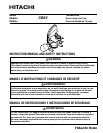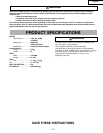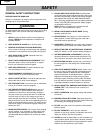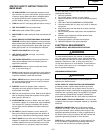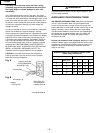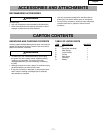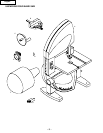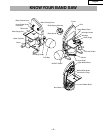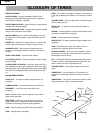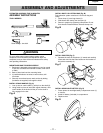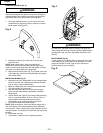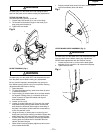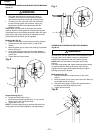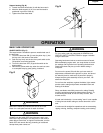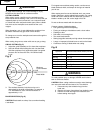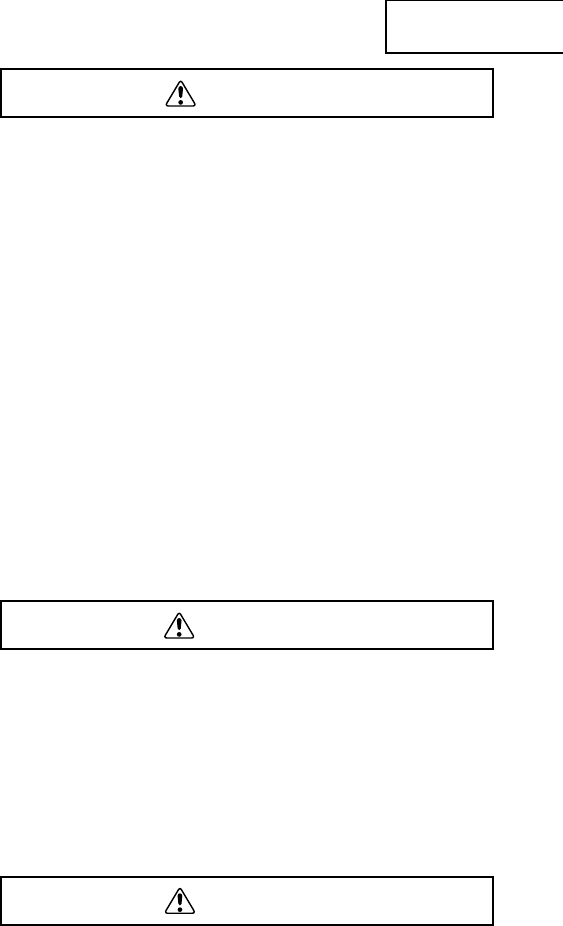
SPECIFIC SAFETY INSTRUCTIONS FOR
BAND SAWS
1. TO AVOID INJURY from unexpected movement, make
sure the saw is on a firm, level surface, properly secured
to prevent rocking. Make sure there is adequate space
for operating. Bolt the saw to a support surface to
prevent slipping, walking, or sliding during operation.
2. TURN the saw OFF and unplug the saw before moving it.
3. USE THE CORRECT size and style blade.
4. USE blades rated at 3600 FPM or greater.
5. MAKE SURE the blade teeth point down and towards the
table.
6. BLADE GUIDES, SUPPORT BEARINGS, AND BLADE
TENSION must be properly adjusted to avoid accidental
blade contact and to minimize blade breakage. To maximize
blade support, always adjust the upper blade guide and
blade guard so that it is 1/8 inch above the workpiece.
7. TABLE LOCK HANDLE should be tight.
8. USE EXTRA CAUTION with large, very small or
awkward workpieces.
9. USE EXTRA SUPPORTS to prevent workpieces from
sliding off the tabletop. Never use another person to
support the workpiece.
10. WORKPIECES must be secured so they don’t twist,
rock, or slip while being cut.
11. PLAN intricate and small work carefully to avoid pinching
the blade. Avoid awkward operation and hand positions
to prevent accidental contact with the blade.
12. SMALL PIECES should be secured with jigs or fixtures.
Do not hand hold pieces that are so small your fingers
are under the blade guard.
13. SUPPORT round work properly (with a V-block or
clamped to the miter gauge) to prevent it from rolling
and the blade from biting.
14. CUT only one workpiece at a time. Make sure the table is
clear of everything except the workpiece and its guides
before you turn the saw on.
15. ALWAYS WATCH the saw run before each use. If there
is excessive vibration or unusual noise, stop immediately.
Turn the saw OFF. Unplug it immediately. Do not start
the saw again until the problem has been located and
corrected.
16. TO FREE any jammed material, turn the switch OFF.
Remove the switch key and unplug the saw. Wait for all
moving parts to stop before removing jammed material.
17. DON’T LEAVE the work area until all moving parts are
stopped. To childproof the workshop, shut OFF the power
to master switches and remove the switch key from the
band saw. Store it in a safe place, away from children.
For your own safety, read the entire instruction manual before
operating the band saw.
1. Wear eye protection.
2. Do not wear gloves, necktie, or loose clothing.
3. Make sure the saw is on a firm level surface and properly
secured.
4. USE ONLY THE RECOMMENDED ACCESSORIES.
5. Use extra caution with very large, very small, or awkward
workpieces.
6. Keep hands away from the blade at all times to prevent
accidental injury.
7. Do not remove jammed cutoff pieces until the blade has
stopped.
8. Maintain proper adjustment of blade tension, blade
guides and thrust bearings.
9. Adjust upper guide to just clear the workpiece.
10. Hold the workpiece firmly against the table.
ELECTRICAL REQUIREMENTS
POWER SUPPLY AND MOTOR SPECIFICATIONS
To avoid electrical hazards, fire hazards, or damage to the
tool, use proper circuit protection. Use a separate electrical
circuit for your tools. Your saw is wired at the factory for 120V
operation. Connect to a 120V, 15 Amp circuit and use a
15 Amp time delay fuse or circuit breaker. To avoid shock or
fire, if power cord is worn or cut, or damaged in any way,
have it replaced immediately.
GROUNDING INSTRUCTIONS
This tool must be grounded while in use to protect the
operator from electrical shock.
IN THE EVENT OF A MALFUNCTION OR BREAKDOWN,
grounding provides a path of least resistance for electric
current and reduces the risk of electric shock. This tool is
equipped with an electric cord that has an equipment-grounding
conductor and a grounding plug. The plug MUST be plugged
into a matching receptacle that is properly installed and
grounded in accordance with ALL local codes and ordinances.
DO NOT MODIFY THE PLUG PROVIDED. If it will not fit the
receptacle, have the proper receptacle installed by a qualified
electrician.
IMPROPER CONNECTION of the equipment-grounding
conductor can result in risk of electric shock. The conductor
with green insulation (with or without yellow stripes) is the
equipment-grounding conductor. If repair or replacement of
the electric cord or plug is necessary, DO NOT connect the
equipment-grounding conductor to a live terminal.
CHECK with a qualified electrician or service person if you
do not completely understand the grounding instructions,
or if you are not sure the tool is properly grounded.
WARNING
WARNING
WARNING
English
– 5 –



